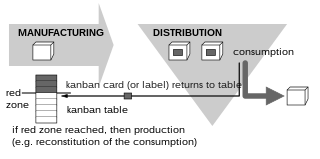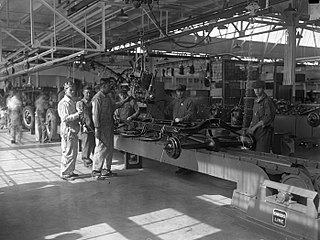
A punched card is a piece of card stock that stores digital data using punched holes. Punched cards were once common in data processing and the control of automated machines.

Lean manufacturing is a production method aimed primarily at reducing times within the production system as well as response times from suppliers and to customers. It is closely related to another concept called just-in-time manufacturing. Just-in-time manufacturing tries to match production to demand by only supplying goods which have been ordered and focuses on efficiency, productivity, and reduction of "wastes" for the producer and supplier of goods. Lean manufacturing adopts the just-in-time approach and additionally focuses on reducing cycle, flow, and throughput times by further eliminating activities which do not add any value for the customer. Lean manufacturing also involves people who work outside of the manufacturing process, such as in marketing and customer service.

Kanban is a scheduling system for lean manufacturing. Taiichi Ohno, an industrial engineer at Toyota, developed kanban to improve manufacturing efficiency. The system takes its name from the cards that track production within a factory. Kanban is also known as the Toyota nameplate system in the automotive industry.
The Toyota Production System (TPS) is an integrated socio-technical system, developed by Toyota, that comprises its management philosophy and practices. The TPS is a management system that organizes manufacturing and logistics for the automobile manufacturer, including interaction with suppliers and customers. The system is a major precursor of the more generic "lean manufacturing". Taiichi Ohno and Eiji Toyoda, Japanese industrial engineers, developed the system between 1948 and 1975.
Lean software development is a translation of lean manufacturing principles and practices to the software development domain. Adapted from the Toyota Production System, it is emerging with the support of a pro-lean subculture within the agile community. Lean offers a solid conceptual framework, values and principles, as well as good practices, derived from experience, that support agile organizations.

Operations management is concerned with designing and controlling the production of goods and services, ensuring that businesses are efficient in using resources to meet customer requirements.
Lean thinking is a management framework made up of a philosophy, practices and principles which aim to help practitioners improve efficiency and the quality of work. Lean thinking encourages whole organisation participation. The goal is to organise human activities to deliver more benefits to society and value to individuals while eliminating waste.

5S is a workplace organization method that uses a list of five Japanese words: seiri (整理), seiton (整頓), seisō (清掃), seiketsu (清潔), and shitsuke (躾). These have been translated as 'sort', 'set in order', 'shine', 'standardize', and 'sustain'. The list describes how to organize a work space for efficiency and effectiveness by identifying and sorting the items used, maintaining the area and items, and sustaining the new organizational system. The decision-making process usually comes from a dialogue about standardization, which builds understanding among employees of how they should do the work.

The business terms push and pull originated in logistics and supply chain management, but are also widely used in marketing and in the hotel distribution business.
Takt time, or simply takt, is a manufacturing term to describe the required product assembly duration that is needed to match the demand. Often confused with cycle time, takt time is a tool used to design work and it measures the average time interval between the start of production of one unit and the start of production of the next unit when items are produced sequentially. For calculations, it is the time to produce parts divided by the number of parts demanded in that time interval. The takt time is based on customer demand; if a process or a production line are unable to produce at takt time, either demand leveling, additional resources, or process re-engineering is needed to ensure on-time delivery.

Production leveling, also known as production smoothing or – by its Japanese original term – heijunka (平準化), is a technique for reducing the mura (unevenness) which in turn reduces muda (waste). It was vital to the development of production efficiency in the Toyota Production System and lean manufacturing. The goal is to produce intermediate goods at a constant rate so that further processing may also be carried out at a constant and predictable rate.
Fixed repeating schedule is a key element of the Toyota Production System and lean manufacturing. As its name suggests it is a production schedule which is 'unchanging' and repeated perhaps daily or over a longer period such as two weeks or month. If it can be implemented, economies of repetition start to become evident and suppliers and customers can be assured in their own activity scheduling. What impedes this being implemented is the uncertainty of demand and supply. Therefore whilst the scheduling becomes simple, the activities to make the scheduling possible become more complex. Thus the planning to move to FRS reveals issues which, if managed correctly, will reduce complexity overall and improve customer service.
Mura is a Japanese word meaning "unevenness; irregularity; lack of uniformity; nonuniformity; inequality", and is a key concept in the Toyota Production System (TPS) as one of the three types of waste. Waste in this context refers to the wasting of time or resources rather than wasteful by-products and should not be confused with Waste reduction. Toyota adopted these three Japanese words as part of their product improvement program, due to their familiarity in common usage.
CONWIP are pull-oriented production control systems. Such systems can be classified as pull and push systems. In a push system, the production order is scheduled, and the material is pushed into the production line. In a pull system, the start of each product assembly process is triggered by the completion of another at the end of production line. This pull-variant is known for its ease of implementation.
Frequent deliveries are a largely ignored but powerful way of leveling apparent demand within a supply chain and thereby reducing Mura. What is perhaps not so obvious is that this will reduce inventory levels and thereby assist progress along the Lean journey at the same time. The historical focus upon carrying full loads, sometimes of only one product, reduces the unit cost of transport but has sometimes hidden the true costs associated with achieving those transport discounts. It is also possible to gain some of these benefits by 'faking' frequent deliveries at the supply site.
Visual control is a business management technique employed in many places where information is communicated by using visual signals instead of texts or other written instructions. The design is deliberate in allowing quick recognition of the information being communicated, in order to increase efficiency and clarity. These signals can be of many forms, from different coloured clothing for different teams, to focusing measures upon the size of the problem and not the size of the activity, to kanban, obeya and heijunka boxes and many other diverse examples. In The Toyota Way, it is also known as mieruka.
Demand Flow Technology (DFT) is a strategy for defining and deploying business processes in a flow, driven in response to customer demand. DFT is based on a set of applied mathematical tools that are used to connect processes in a flow and link it to daily changes in demand. DFT represents a scientific approach to flow manufacturing for discrete production. It is built on principles of demand pull where customer demand is the central signal to guide factory and office activity in the daily operation. DFT is intended to provide an alternative to schedule-push manufacturing which primarily uses a sales plan and forecast to determine a production schedule.

Kanban is a lean method to manage and improve work across human systems. This approach aims to manage work by balancing demands with available capacity, and by improving the handling of system-level bottlenecks.

A kanban board is one of the tools that can be used to implement kanban to manage work at a personal or organizational level.
UNICOM Focal Point is a portfolio management and decision analysis tool used by the product organizations of corporations and government agencies to collect information and feedback from internal and external stakeholders on the value of applications, products, systems, technologies, capabilities, ideas, and other organizational artifacts—prioritize on which ones will provide the most value to the business, and manage the roadmap of how artifacts will be fielded, improved, or removed from the market or organization. UNICOM Focal Point is also used to manage a portfolio of projects, to understand resources used on those projects, and timelines for completion. The product is also used for pure product management—where product managers use it to gather and analyze enhancement requests from customers to decide on what features to put in a product, and develop roadmaps for future product versions.








